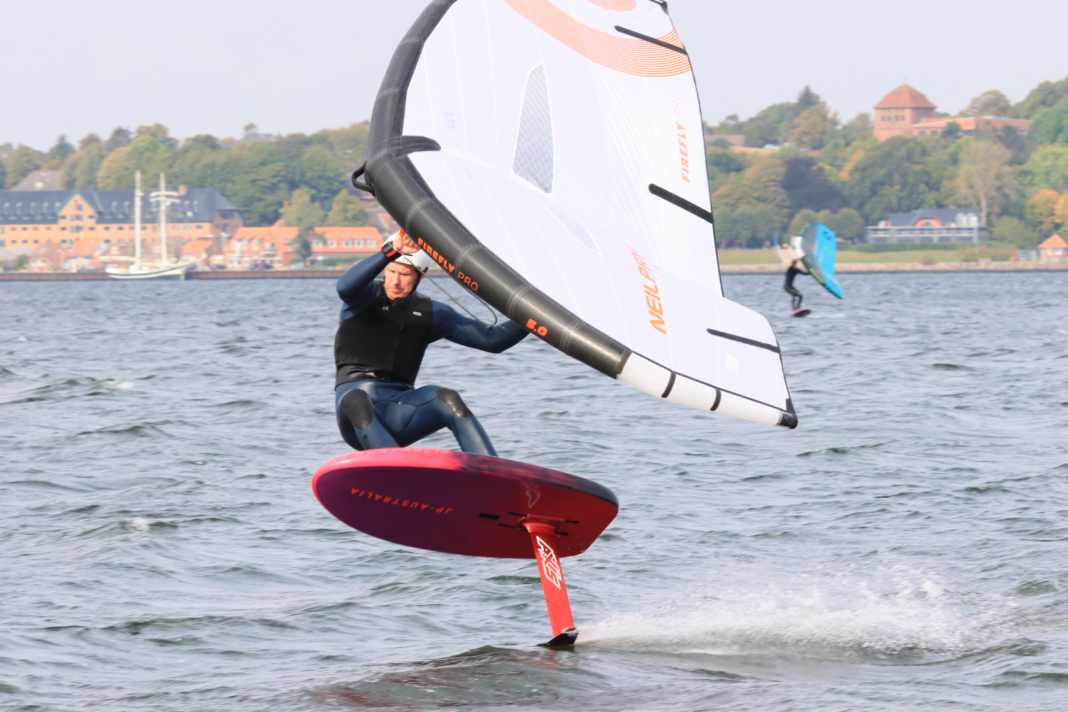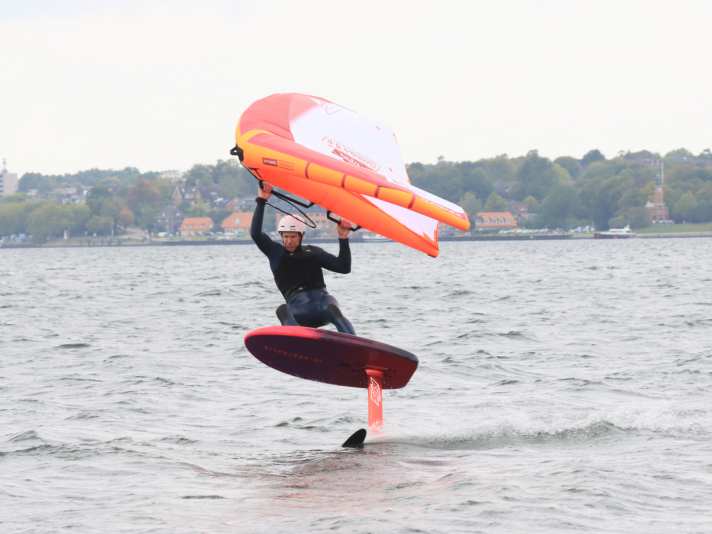





The Axis Spitfire front wing is available in ten (!) sizes (620 to 1180), the specifications here refer to the wingspan in millimetres, not the surface area. We tested the Spitfire 900 with a wing area of 1099 cm2, in combination with the Black Series Short Fuselage (69.9 centimetres), two different rear wings (Progressive 300 and Progressive 350) and an 82 mm aluminium mast. We reveal the strengths and weaknesses of the foil in the test.
On land
The Spitfire range includes ten front wings with spans between 620 and 1180 millimetres. Important to know: The aspect ratio (the ratio of wingspan to surface area) changes within the Spitfire range. For example, the large 1180 wing has an aspect ratio of 9.13, while the smallest wing with a span of 620 millimetres only has an aspect ratio of 6.12. The 900 front wing we tested has a medium profile thickness in the centre area, with a thin profile towards the wing tips. The screw connections to the fuselage are very precise and solid, all screw lengths are printed on the wing so that there is no chance of confusion during assembly. The fuselage is attached to the mast with two thick M10 bolts. The mounting plate on the pole allows the bolts to be inserted from the side to save time. The plate also has additional holes so that the foil can be pushed far forwards or backwards in short boxes.

On the water
In order for the Spitfire 900 to generate even lift when starting off, it needs a little more basic speed. That's why you should deliberately keep the board flat when pumping up and continue to generate speed before letting it take off. If you go up too early, the board will sink abruptly back to the surface. Once lifted, the foil with the tested Black Series Short fuselage and the 300 mm back wing are quite agile around all axles. Those who are already confident foiling will enjoy the surprisingly smooth turning behaviour and the fact that even a little pressure is enough to initiate the turn. The setup allows fast pumping movements over the foil so that you can milk the energy from small swells and convert it into long flights. The aforementioned agility is somewhat reversed under the feet of less experienced foilers, in which case you would definitely want a little more flight stability in order to be able to control altitude and turn radii in a more relaxed manner. We liked the foil better in combination with the Progressive 350 Stabilizer - the flight behaviour is then noticeably more stable and the foil seems easier to ride. We would also advise experienced foilers to combine it with the 350 back wing, as this minimises the disadvantages while retaining the strengths.
In addition to its smooth manoeuvrability, the Axis Spitfire 900 has many other strengths: it achieves a good top speed and scores particularly well with good glide. Even on waist-high Baltic swell, you can make plenty of metres with the wing in a neutral position without the wing pushing the surface. Although the Spitfire doesn't quite achieve the glide and speed level of its sister model, the ART, it does manage smoother radii and tighter hooks.

Axis Spitfire 900 - the conclusion
If you have some experience, are already a confident foiler and no longer need to worry about standard manoeuvres, the Spitfire is a fast and easy-turning foil that is particularly suitable for downwinders, smooth turns in moderate swell and jumping. The model BSC (HERE is a test) flies much easier and more stable in the Axis-internal comparison - freeriders and beginners to foiling are clearly better served here.
Glide, ease of turning
Suitability for foil beginners
Axis Spitfire - technical data
- Test model: Axis Spitfire 900
- Front wing area: 1099 cm2
- Front wing span90.0 cm (aspect ratio 7.25)
- Back wing area: 150 cm2
- Wingspan back wing: 30.0 cm
- Fuselage (aluminium): 70.3 cm
- Mast (aluminium): 82 cm
- Price test set: 1704 Euro
- Weight set (own measurement): 4.29 kg
- Contact: To the website
- Scope of delivery: Cover, screws, tools
- Special features: -

